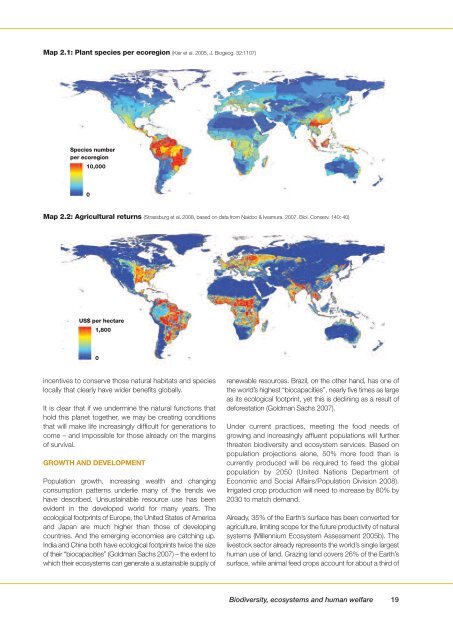Interim Report - TEEB
Interim Report - TEEB
Interim Report - TEEB
You also want an ePaper? Increase the reach of your titles
YUMPU automatically turns print PDFs into web optimized ePapers that Google loves.
Map 2.1: Plant species per ecoregion (Kier et al. 2005, J. Biogeog. 32:1107)<br />
Species number<br />
per ecoregion<br />
10,000<br />
0<br />
Map 2.2: Agricultural returns (Strassburg et al. 2008, based on data from Naidoo & Iwamura. 2007. Biol. Conserv. 140: 40)<br />
US$ per hectare<br />
1,800<br />
0<br />
incentives to conserve those natural habitats and species<br />
locally that clearly have wider benefits globally.<br />
It is clear that if we undermine the natural functions that<br />
hold this planet together, we may be creating conditions<br />
that will make life increasingly difficult for generations to<br />
come – and impossible for those already on the margins<br />
of survival.<br />
GROWTH AND DEVELOPMENT<br />
Population growth, increasing wealth and changing<br />
consumption patterns underlie many of the trends we<br />
have described. Unsustainable resource use has been<br />
evident in the developed world for many years. The<br />
ecological footprints of Europe, the United States of America<br />
and Japan are much higher than those of developing<br />
countries. And the emerging economies are catching up.<br />
India and China both have ecological footprints twice the size<br />
of their “biocapacities” (Goldman Sachs 2007) – the extent to<br />
which their ecosystems can generate a sustainable supply of<br />
renewable resources. Brazil, on the other hand, has one of<br />
the world’s highest “biocapacities”, nearly five times as large<br />
as its ecological footprint, yet this is declining as a result of<br />
deforestation (Goldman Sachs 2007).<br />
Under current practices, meeting the food needs of<br />
growing and increasingly affluent populations will further<br />
threaten biodiversity and ecosystem services. Based on<br />
population projections alone, 50% more food than is<br />
currently produced will be required to feed the global<br />
population by 2050 (United Nations Department of<br />
Economic and Social Affairs/Population Division 2008).<br />
Irrigated crop production will need to increase by 80% by<br />
2030 to match demand.<br />
Already, 35% of the Earth’s surface has been converted for<br />
agriculture, limiting scope for the future productivity of natural<br />
systems (Millennium Ecosystem Assessment 2005b). The<br />
livestock sector already represents the world’s single largest<br />
human use of land. Grazing land covers 26% of the Earth’s<br />
surface, while animal feed crops account for about a third of<br />
Biodiversity, ecosystems and human welfare<br />
19

















